Strategies to Cut Costs in Healthcare: Business Plan Analysis (2024)
VerifiedAdded on 2020/05/16
|24
|4883
|49
Report
AI Summary
This business plan examines strategies to reduce healthcare costs, a significant concern for policymakers and patients. The report analyzes the impact of unnecessary medical tests on rising healthcare expenses and proposes solutions through algorithms, process maps, and new procedures. It defines project objectives, including the implementation of electronic systems to monitor and manage test prescriptions, and explores the financial and staff implications of these changes. Cost-benefit analyses, timelines, and evaluation tools are included to ensure quality healthcare at affordable costs. The plan recommends adopting new strategies and implementing them to improve financial efficiency and patient outcomes, focusing on optimizing resource allocation, providing continuous training, and adapting to new procedures to meet healthcare goals effectively. The plan also discusses financial implications and incentives, aiming for a 10% cost reduction through enhanced cost management and improved patient care, ultimately contributing to better value in healthcare delivery.
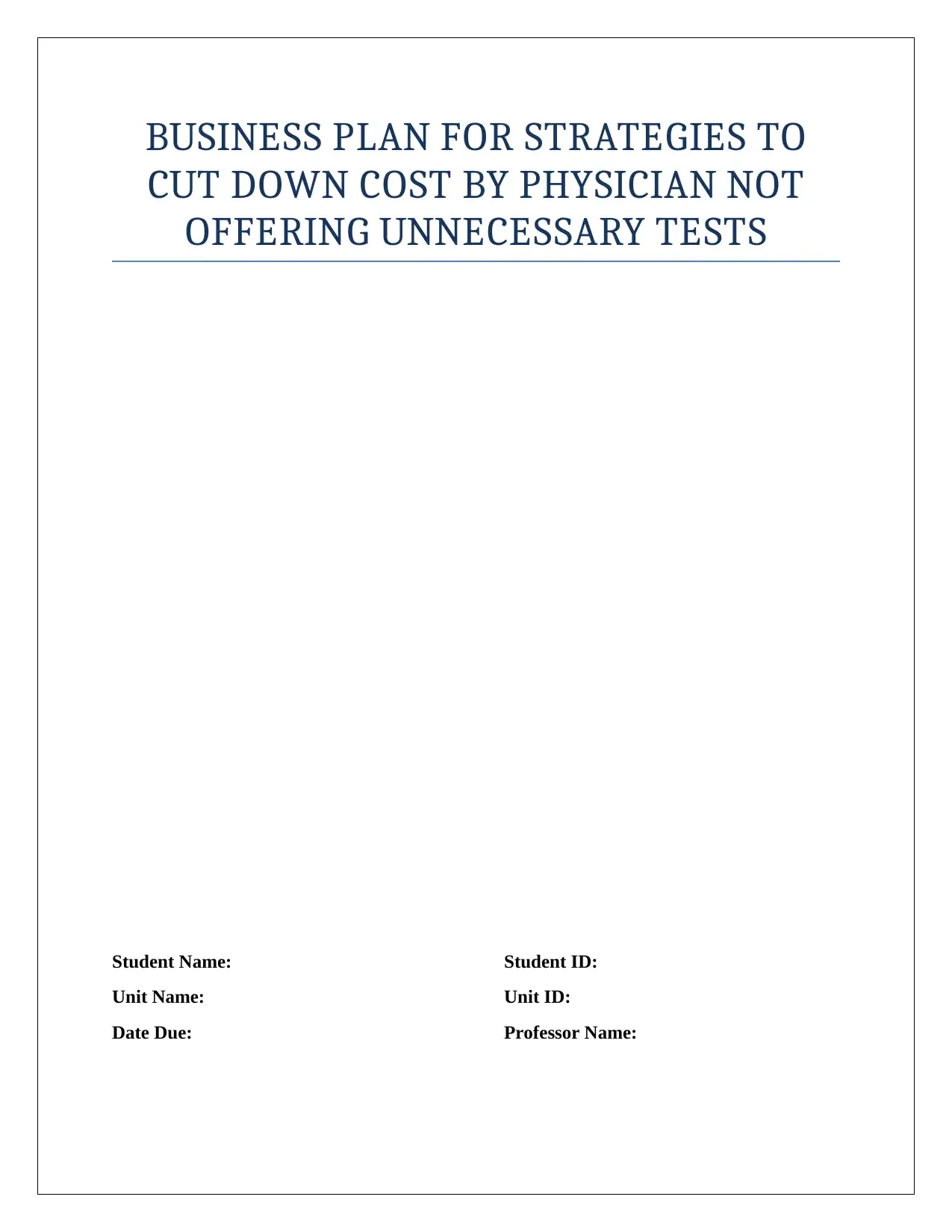
BUSINESS PLAN FOR STRATEGIES TO
CUT DOWN COST BY PHYSICIAN NOT
OFFERING UNNECESSARY TESTS
Student Name: Student ID:
Unit Name: Unit ID:
Date Due: Professor Name:
CUT DOWN COST BY PHYSICIAN NOT
OFFERING UNNECESSARY TESTS
Student Name: Student ID:
Unit Name: Unit ID:
Date Due: Professor Name:
Paraphrase This Document
Need a fresh take? Get an instant paraphrase of this document with our AI Paraphraser
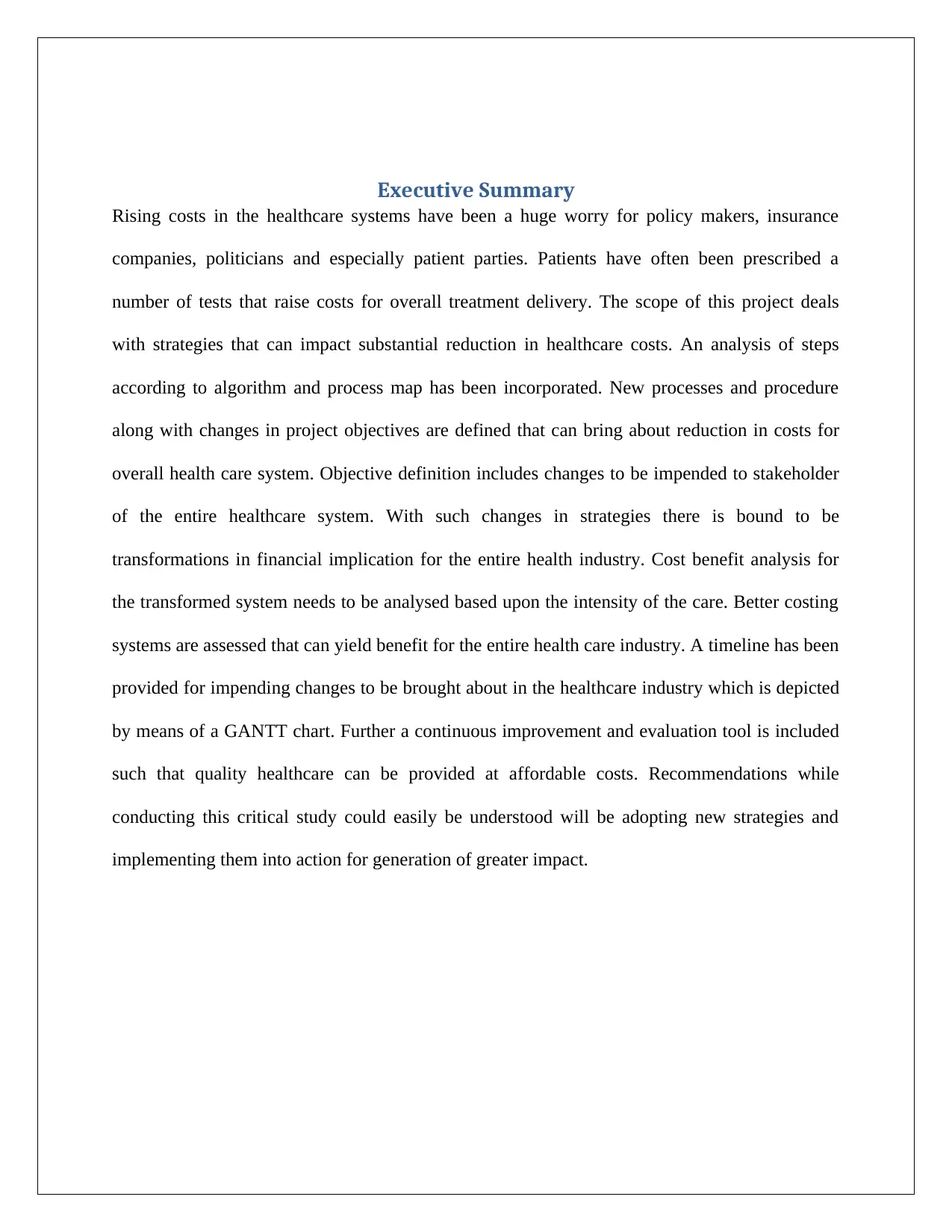
Executive Summary
Rising costs in the healthcare systems have been a huge worry for policy makers, insurance
companies, politicians and especially patient parties. Patients have often been prescribed a
number of tests that raise costs for overall treatment delivery. The scope of this project deals
with strategies that can impact substantial reduction in healthcare costs. An analysis of steps
according to algorithm and process map has been incorporated. New processes and procedure
along with changes in project objectives are defined that can bring about reduction in costs for
overall health care system. Objective definition includes changes to be impended to stakeholder
of the entire healthcare system. With such changes in strategies there is bound to be
transformations in financial implication for the entire health industry. Cost benefit analysis for
the transformed system needs to be analysed based upon the intensity of the care. Better costing
systems are assessed that can yield benefit for the entire health care industry. A timeline has been
provided for impending changes to be brought about in the healthcare industry which is depicted
by means of a GANTT chart. Further a continuous improvement and evaluation tool is included
such that quality healthcare can be provided at affordable costs. Recommendations while
conducting this critical study could easily be understood will be adopting new strategies and
implementing them into action for generation of greater impact.
Rising costs in the healthcare systems have been a huge worry for policy makers, insurance
companies, politicians and especially patient parties. Patients have often been prescribed a
number of tests that raise costs for overall treatment delivery. The scope of this project deals
with strategies that can impact substantial reduction in healthcare costs. An analysis of steps
according to algorithm and process map has been incorporated. New processes and procedure
along with changes in project objectives are defined that can bring about reduction in costs for
overall health care system. Objective definition includes changes to be impended to stakeholder
of the entire healthcare system. With such changes in strategies there is bound to be
transformations in financial implication for the entire health industry. Cost benefit analysis for
the transformed system needs to be analysed based upon the intensity of the care. Better costing
systems are assessed that can yield benefit for the entire health care industry. A timeline has been
provided for impending changes to be brought about in the healthcare industry which is depicted
by means of a GANTT chart. Further a continuous improvement and evaluation tool is included
such that quality healthcare can be provided at affordable costs. Recommendations while
conducting this critical study could easily be understood will be adopting new strategies and
implementing them into action for generation of greater impact.
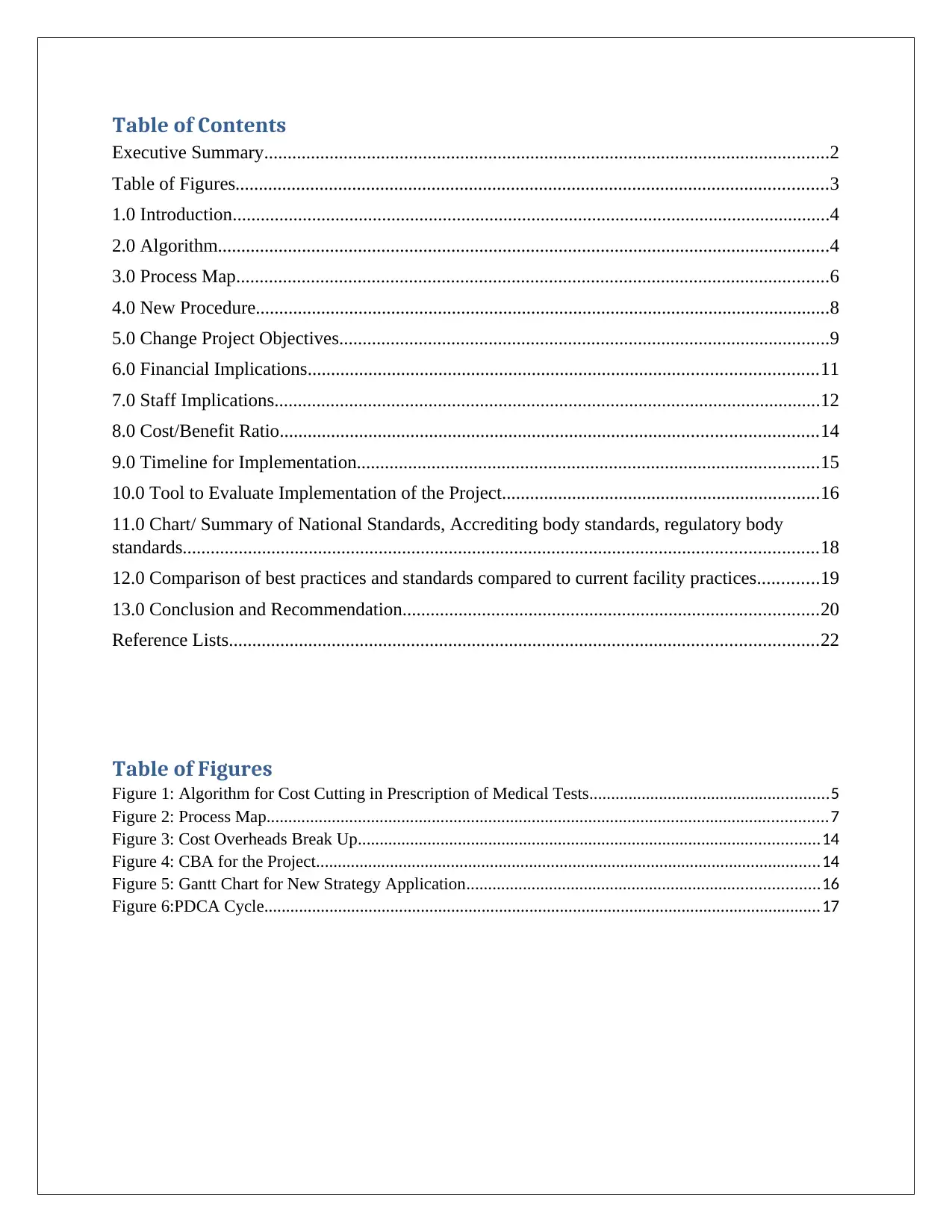
Table of Contents
Executive Summary.........................................................................................................................2
Table of Figures...............................................................................................................................3
1.0 Introduction................................................................................................................................4
2.0 Algorithm...................................................................................................................................4
3.0 Process Map...............................................................................................................................6
4.0 New Procedure...........................................................................................................................8
5.0 Change Project Objectives.........................................................................................................9
6.0 Financial Implications.............................................................................................................11
7.0 Staff Implications.....................................................................................................................12
8.0 Cost/Benefit Ratio...................................................................................................................14
9.0 Timeline for Implementation...................................................................................................15
10.0 Tool to Evaluate Implementation of the Project....................................................................16
11.0 Chart/ Summary of National Standards, Accrediting body standards, regulatory body
standards........................................................................................................................................18
12.0 Comparison of best practices and standards compared to current facility practices.............19
13.0 Conclusion and Recommendation.........................................................................................20
Reference Lists..............................................................................................................................22
Table of Figures
Figure 1: Algorithm for Cost Cutting in Prescription of Medical Tests.......................................................5
Figure 2: Process Map.................................................................................................................................7
Figure 3: Cost Overheads Break Up..........................................................................................................14
Figure 4: CBA for the Project....................................................................................................................14
Figure 5: Gantt Chart for New Strategy Application.................................................................................16
Figure 6:PDCA Cycle................................................................................................................................17
Executive Summary.........................................................................................................................2
Table of Figures...............................................................................................................................3
1.0 Introduction................................................................................................................................4
2.0 Algorithm...................................................................................................................................4
3.0 Process Map...............................................................................................................................6
4.0 New Procedure...........................................................................................................................8
5.0 Change Project Objectives.........................................................................................................9
6.0 Financial Implications.............................................................................................................11
7.0 Staff Implications.....................................................................................................................12
8.0 Cost/Benefit Ratio...................................................................................................................14
9.0 Timeline for Implementation...................................................................................................15
10.0 Tool to Evaluate Implementation of the Project....................................................................16
11.0 Chart/ Summary of National Standards, Accrediting body standards, regulatory body
standards........................................................................................................................................18
12.0 Comparison of best practices and standards compared to current facility practices.............19
13.0 Conclusion and Recommendation.........................................................................................20
Reference Lists..............................................................................................................................22
Table of Figures
Figure 1: Algorithm for Cost Cutting in Prescription of Medical Tests.......................................................5
Figure 2: Process Map.................................................................................................................................7
Figure 3: Cost Overheads Break Up..........................................................................................................14
Figure 4: CBA for the Project....................................................................................................................14
Figure 5: Gantt Chart for New Strategy Application.................................................................................16
Figure 6:PDCA Cycle................................................................................................................................17
⊘ This is a preview!⊘
Do you want full access?
Subscribe today to unlock all pages.

Trusted by 1+ million students worldwide
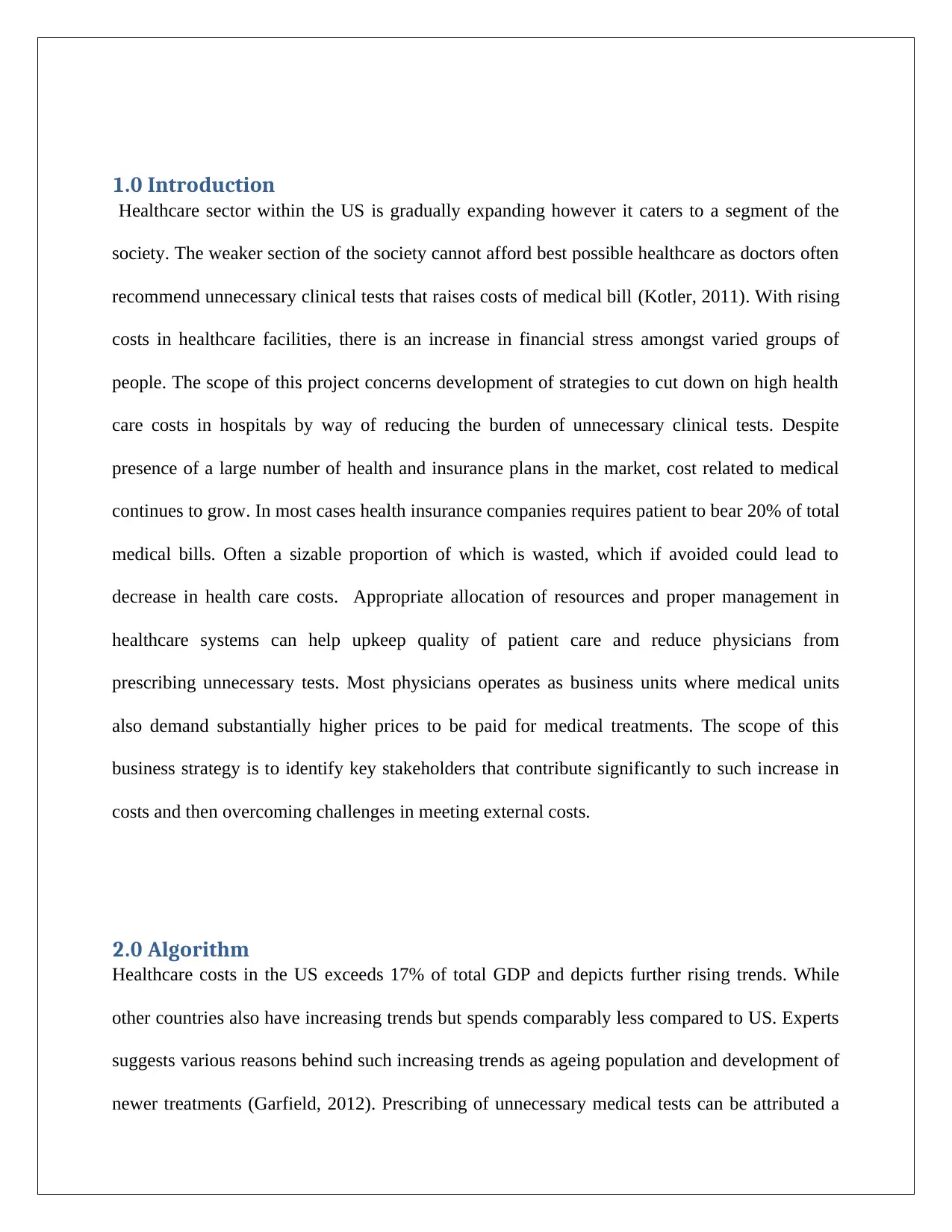
1.0 Introduction
Healthcare sector within the US is gradually expanding however it caters to a segment of the
society. The weaker section of the society cannot afford best possible healthcare as doctors often
recommend unnecessary clinical tests that raises costs of medical bill (Kotler, 2011). With rising
costs in healthcare facilities, there is an increase in financial stress amongst varied groups of
people. The scope of this project concerns development of strategies to cut down on high health
care costs in hospitals by way of reducing the burden of unnecessary clinical tests. Despite
presence of a large number of health and insurance plans in the market, cost related to medical
continues to grow. In most cases health insurance companies requires patient to bear 20% of total
medical bills. Often a sizable proportion of which is wasted, which if avoided could lead to
decrease in health care costs. Appropriate allocation of resources and proper management in
healthcare systems can help upkeep quality of patient care and reduce physicians from
prescribing unnecessary tests. Most physicians operates as business units where medical units
also demand substantially higher prices to be paid for medical treatments. The scope of this
business strategy is to identify key stakeholders that contribute significantly to such increase in
costs and then overcoming challenges in meeting external costs.
2.0 Algorithm
Healthcare costs in the US exceeds 17% of total GDP and depicts further rising trends. While
other countries also have increasing trends but spends comparably less compared to US. Experts
suggests various reasons behind such increasing trends as ageing population and development of
newer treatments (Garfield, 2012). Prescribing of unnecessary medical tests can be attributed a
Healthcare sector within the US is gradually expanding however it caters to a segment of the
society. The weaker section of the society cannot afford best possible healthcare as doctors often
recommend unnecessary clinical tests that raises costs of medical bill (Kotler, 2011). With rising
costs in healthcare facilities, there is an increase in financial stress amongst varied groups of
people. The scope of this project concerns development of strategies to cut down on high health
care costs in hospitals by way of reducing the burden of unnecessary clinical tests. Despite
presence of a large number of health and insurance plans in the market, cost related to medical
continues to grow. In most cases health insurance companies requires patient to bear 20% of total
medical bills. Often a sizable proportion of which is wasted, which if avoided could lead to
decrease in health care costs. Appropriate allocation of resources and proper management in
healthcare systems can help upkeep quality of patient care and reduce physicians from
prescribing unnecessary tests. Most physicians operates as business units where medical units
also demand substantially higher prices to be paid for medical treatments. The scope of this
business strategy is to identify key stakeholders that contribute significantly to such increase in
costs and then overcoming challenges in meeting external costs.
2.0 Algorithm
Healthcare costs in the US exceeds 17% of total GDP and depicts further rising trends. While
other countries also have increasing trends but spends comparably less compared to US. Experts
suggests various reasons behind such increasing trends as ageing population and development of
newer treatments (Garfield, 2012). Prescribing of unnecessary medical tests can be attributed a
Paraphrase This Document
Need a fresh take? Get an instant paraphrase of this document with our AI Paraphraser
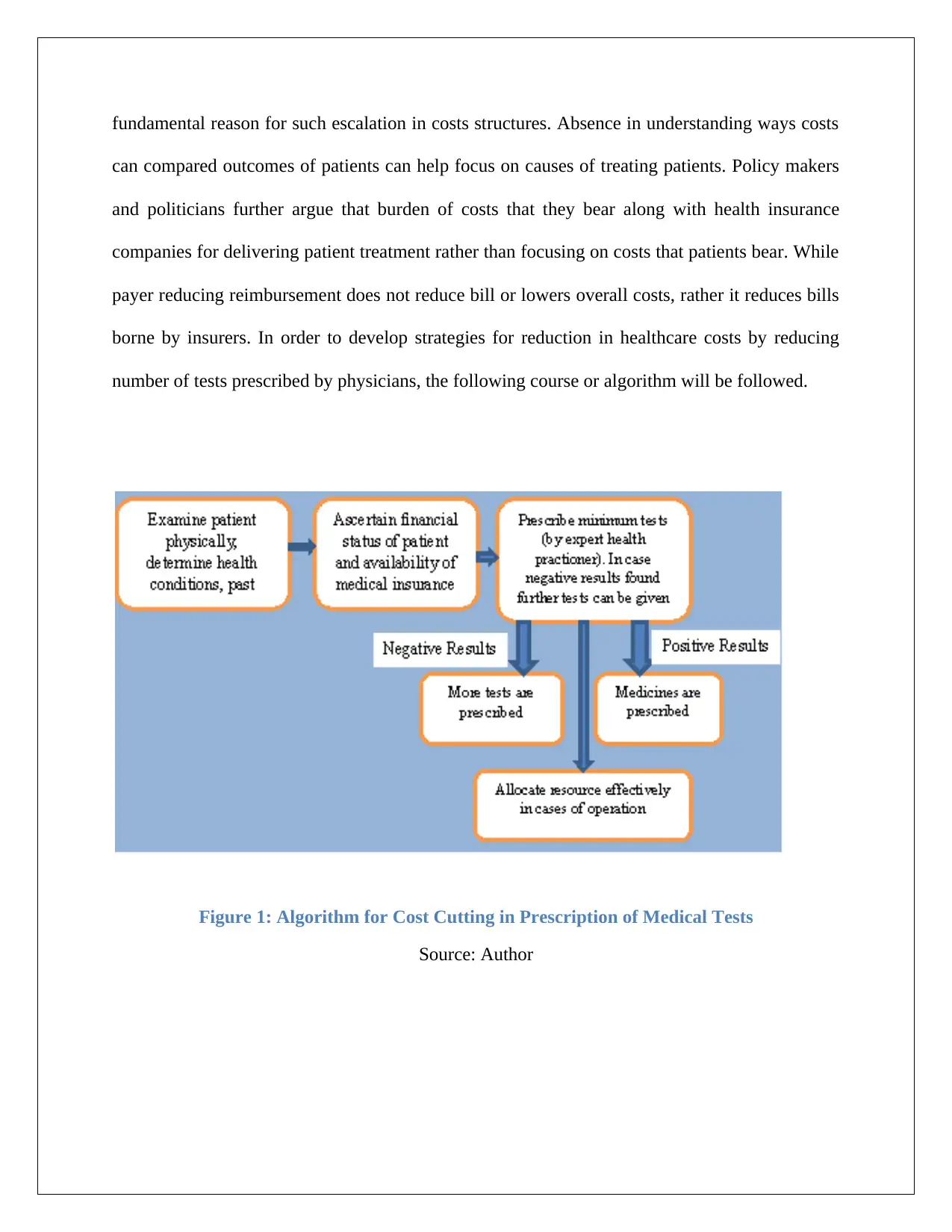
fundamental reason for such escalation in costs structures. Absence in understanding ways costs
can compared outcomes of patients can help focus on causes of treating patients. Policy makers
and politicians further argue that burden of costs that they bear along with health insurance
companies for delivering patient treatment rather than focusing on costs that patients bear. While
payer reducing reimbursement does not reduce bill or lowers overall costs, rather it reduces bills
borne by insurers. In order to develop strategies for reduction in healthcare costs by reducing
number of tests prescribed by physicians, the following course or algorithm will be followed.
Figure 1: Algorithm for Cost Cutting in Prescription of Medical Tests
Source: Author
can compared outcomes of patients can help focus on causes of treating patients. Policy makers
and politicians further argue that burden of costs that they bear along with health insurance
companies for delivering patient treatment rather than focusing on costs that patients bear. While
payer reducing reimbursement does not reduce bill or lowers overall costs, rather it reduces bills
borne by insurers. In order to develop strategies for reduction in healthcare costs by reducing
number of tests prescribed by physicians, the following course or algorithm will be followed.
Figure 1: Algorithm for Cost Cutting in Prescription of Medical Tests
Source: Author
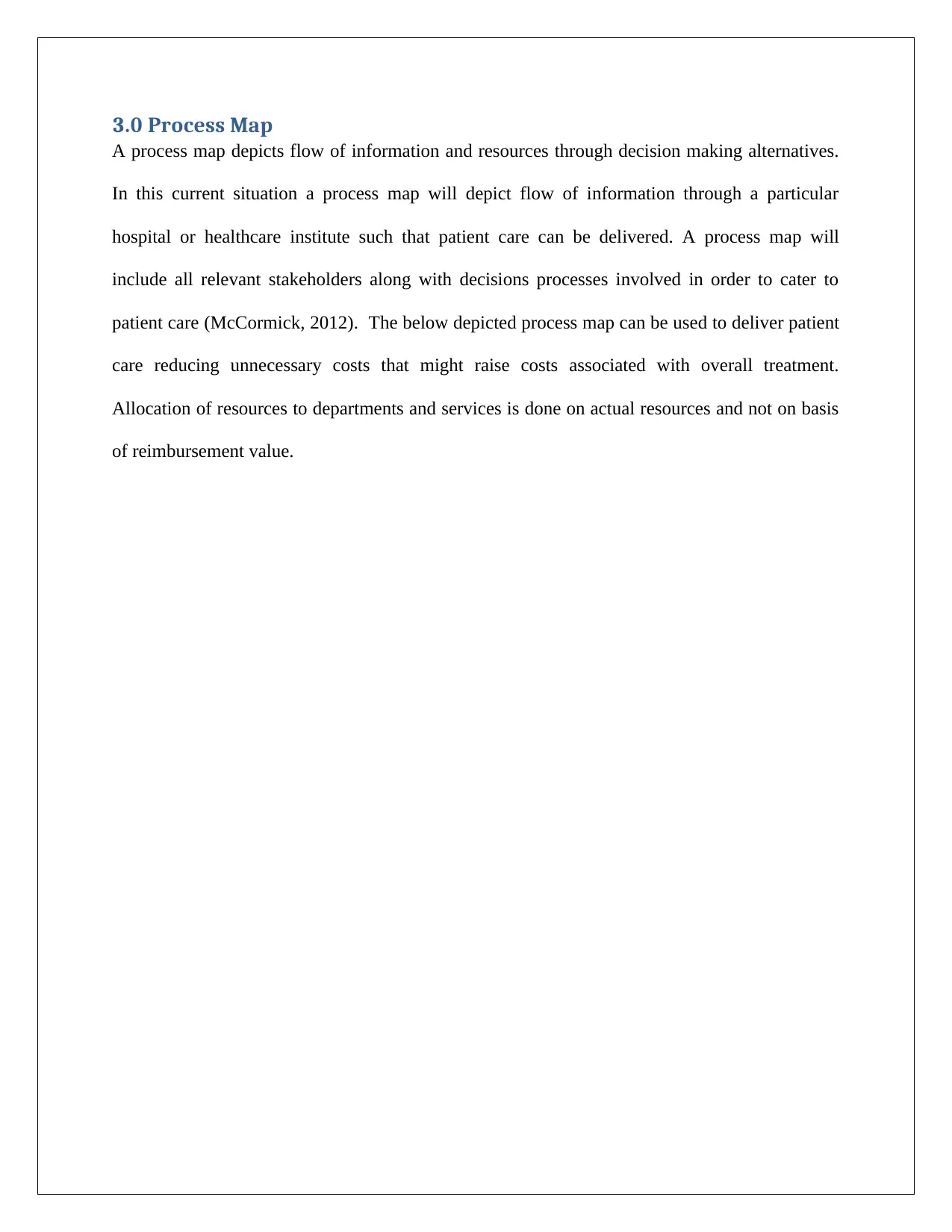
3.0 Process Map
A process map depicts flow of information and resources through decision making alternatives.
In this current situation a process map will depict flow of information through a particular
hospital or healthcare institute such that patient care can be delivered. A process map will
include all relevant stakeholders along with decisions processes involved in order to cater to
patient care (McCormick, 2012). The below depicted process map can be used to deliver patient
care reducing unnecessary costs that might raise costs associated with overall treatment.
Allocation of resources to departments and services is done on actual resources and not on basis
of reimbursement value.
A process map depicts flow of information and resources through decision making alternatives.
In this current situation a process map will depict flow of information through a particular
hospital or healthcare institute such that patient care can be delivered. A process map will
include all relevant stakeholders along with decisions processes involved in order to cater to
patient care (McCormick, 2012). The below depicted process map can be used to deliver patient
care reducing unnecessary costs that might raise costs associated with overall treatment.
Allocation of resources to departments and services is done on actual resources and not on basis
of reimbursement value.
⊘ This is a preview!⊘
Do you want full access?
Subscribe today to unlock all pages.

Trusted by 1+ million students worldwide
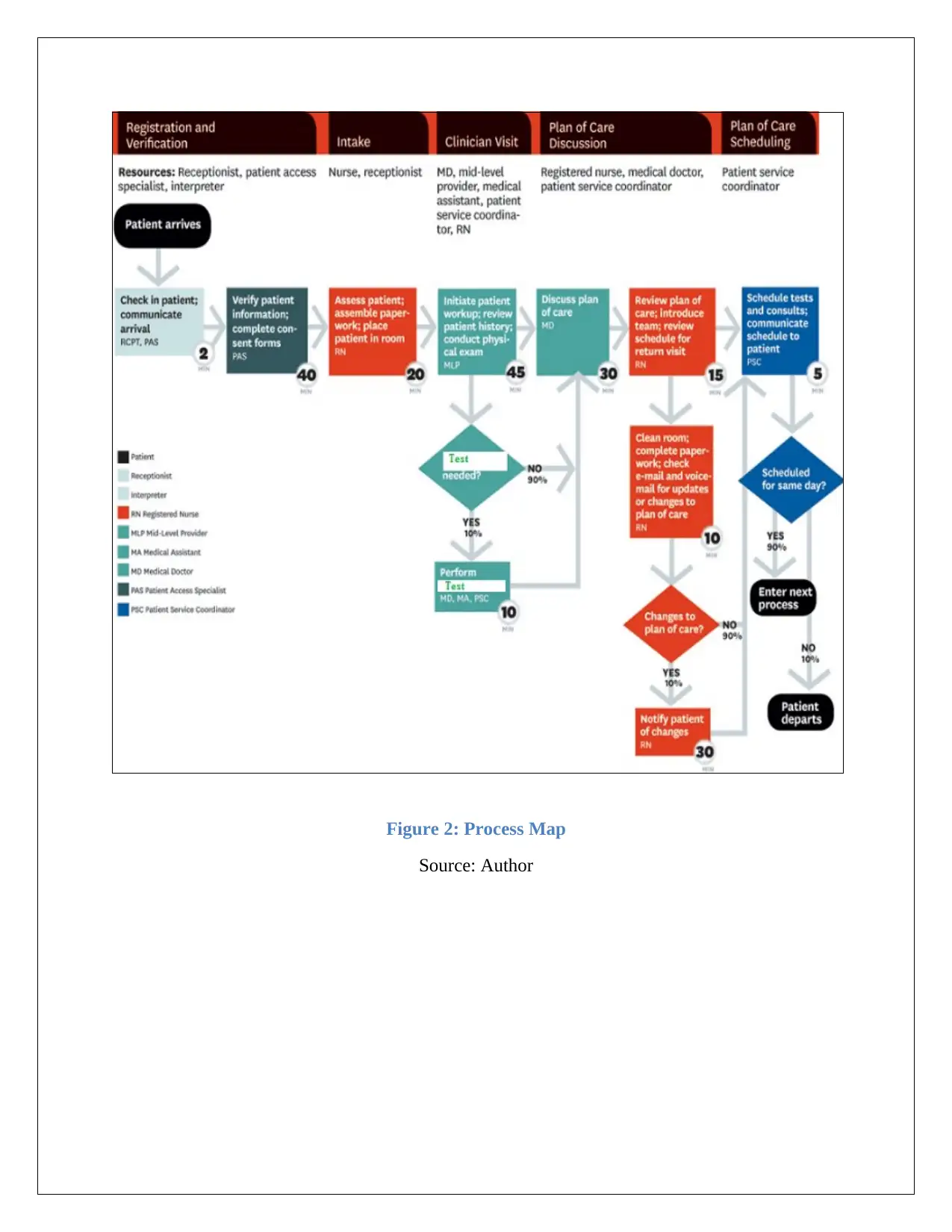
Figure 2: Process Map
Source: Author
Source: Author
Paraphrase This Document
Need a fresh take? Get an instant paraphrase of this document with our AI Paraphraser
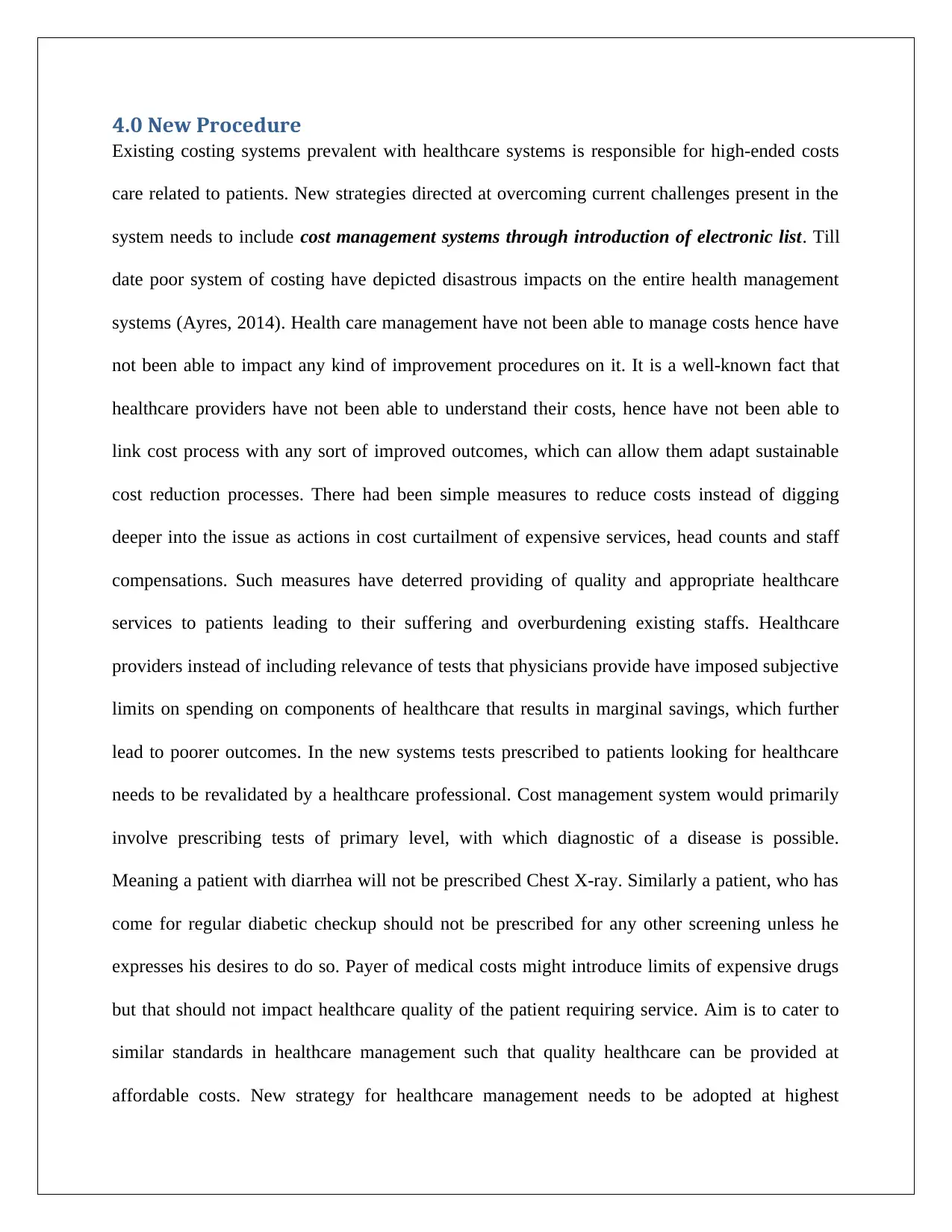
4.0 New Procedure
Existing costing systems prevalent with healthcare systems is responsible for high-ended costs
care related to patients. New strategies directed at overcoming current challenges present in the
system needs to include cost management systems through introduction of electronic list. Till
date poor system of costing have depicted disastrous impacts on the entire health management
systems (Ayres, 2014). Health care management have not been able to manage costs hence have
not been able to impact any kind of improvement procedures on it. It is a well-known fact that
healthcare providers have not been able to understand their costs, hence have not been able to
link cost process with any sort of improved outcomes, which can allow them adapt sustainable
cost reduction processes. There had been simple measures to reduce costs instead of digging
deeper into the issue as actions in cost curtailment of expensive services, head counts and staff
compensations. Such measures have deterred providing of quality and appropriate healthcare
services to patients leading to their suffering and overburdening existing staffs. Healthcare
providers instead of including relevance of tests that physicians provide have imposed subjective
limits on spending on components of healthcare that results in marginal savings, which further
lead to poorer outcomes. In the new systems tests prescribed to patients looking for healthcare
needs to be revalidated by a healthcare professional. Cost management system would primarily
involve prescribing tests of primary level, with which diagnostic of a disease is possible.
Meaning a patient with diarrhea will not be prescribed Chest X-ray. Similarly a patient, who has
come for regular diabetic checkup should not be prescribed for any other screening unless he
expresses his desires to do so. Payer of medical costs might introduce limits of expensive drugs
but that should not impact healthcare quality of the patient requiring service. Aim is to cater to
similar standards in healthcare management such that quality healthcare can be provided at
affordable costs. New strategy for healthcare management needs to be adopted at highest
Existing costing systems prevalent with healthcare systems is responsible for high-ended costs
care related to patients. New strategies directed at overcoming current challenges present in the
system needs to include cost management systems through introduction of electronic list. Till
date poor system of costing have depicted disastrous impacts on the entire health management
systems (Ayres, 2014). Health care management have not been able to manage costs hence have
not been able to impact any kind of improvement procedures on it. It is a well-known fact that
healthcare providers have not been able to understand their costs, hence have not been able to
link cost process with any sort of improved outcomes, which can allow them adapt sustainable
cost reduction processes. There had been simple measures to reduce costs instead of digging
deeper into the issue as actions in cost curtailment of expensive services, head counts and staff
compensations. Such measures have deterred providing of quality and appropriate healthcare
services to patients leading to their suffering and overburdening existing staffs. Healthcare
providers instead of including relevance of tests that physicians provide have imposed subjective
limits on spending on components of healthcare that results in marginal savings, which further
lead to poorer outcomes. In the new systems tests prescribed to patients looking for healthcare
needs to be revalidated by a healthcare professional. Cost management system would primarily
involve prescribing tests of primary level, with which diagnostic of a disease is possible.
Meaning a patient with diarrhea will not be prescribed Chest X-ray. Similarly a patient, who has
come for regular diabetic checkup should not be prescribed for any other screening unless he
expresses his desires to do so. Payer of medical costs might introduce limits of expensive drugs
but that should not impact healthcare quality of the patient requiring service. Aim is to cater to
similar standards in healthcare management such that quality healthcare can be provided at
affordable costs. New strategy for healthcare management needs to be adopted at highest
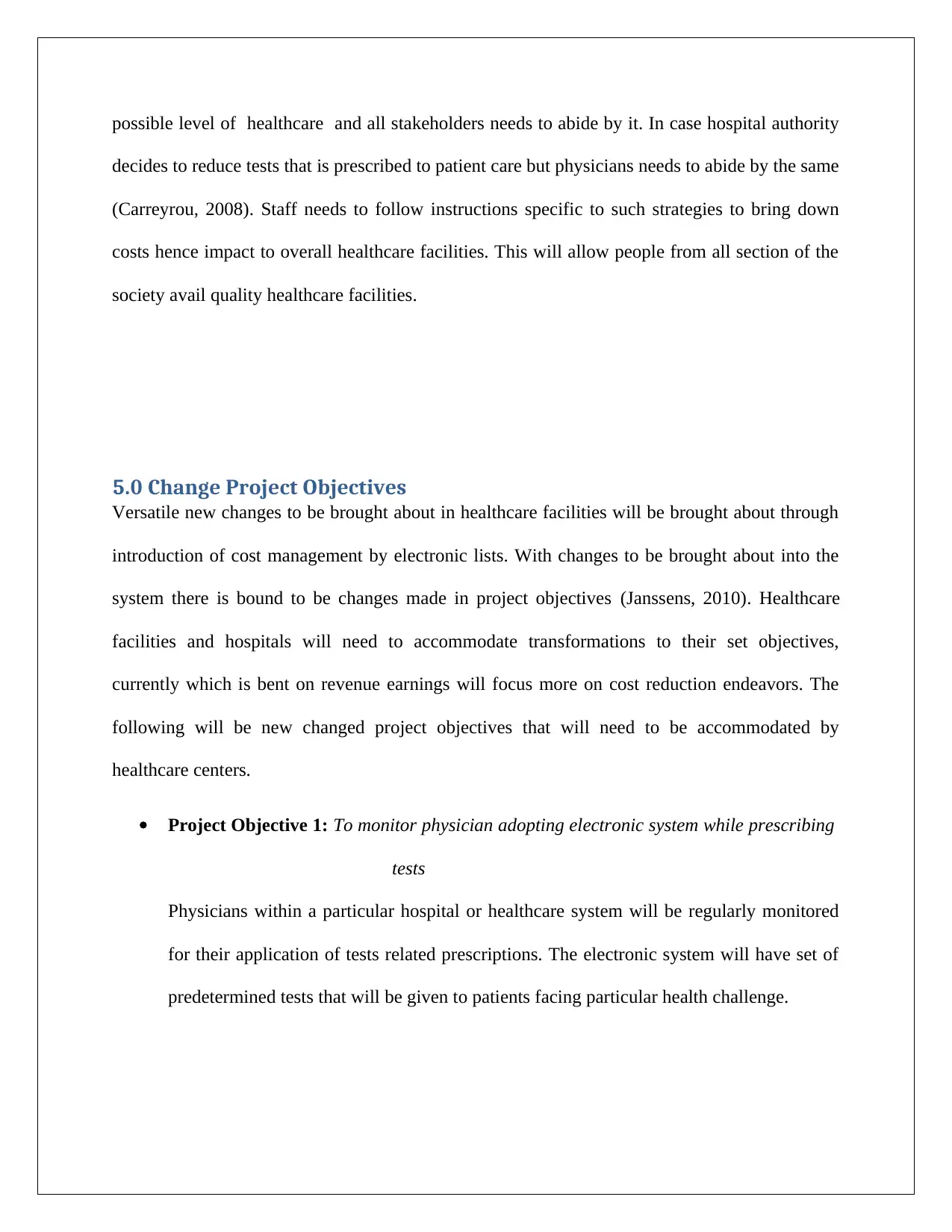
possible level of healthcare and all stakeholders needs to abide by it. In case hospital authority
decides to reduce tests that is prescribed to patient care but physicians needs to abide by the same
(Carreyrou, 2008). Staff needs to follow instructions specific to such strategies to bring down
costs hence impact to overall healthcare facilities. This will allow people from all section of the
society avail quality healthcare facilities.
5.0 Change Project Objectives
Versatile new changes to be brought about in healthcare facilities will be brought about through
introduction of cost management by electronic lists. With changes to be brought about into the
system there is bound to be changes made in project objectives (Janssens, 2010). Healthcare
facilities and hospitals will need to accommodate transformations to their set objectives,
currently which is bent on revenue earnings will focus more on cost reduction endeavors. The
following will be new changed project objectives that will need to be accommodated by
healthcare centers.
Project Objective 1: To monitor physician adopting electronic system while prescribing
tests
Physicians within a particular hospital or healthcare system will be regularly monitored
for their application of tests related prescriptions. The electronic system will have set of
predetermined tests that will be given to patients facing particular health challenge.
decides to reduce tests that is prescribed to patient care but physicians needs to abide by the same
(Carreyrou, 2008). Staff needs to follow instructions specific to such strategies to bring down
costs hence impact to overall healthcare facilities. This will allow people from all section of the
society avail quality healthcare facilities.
5.0 Change Project Objectives
Versatile new changes to be brought about in healthcare facilities will be brought about through
introduction of cost management by electronic lists. With changes to be brought about into the
system there is bound to be changes made in project objectives (Janssens, 2010). Healthcare
facilities and hospitals will need to accommodate transformations to their set objectives,
currently which is bent on revenue earnings will focus more on cost reduction endeavors. The
following will be new changed project objectives that will need to be accommodated by
healthcare centers.
Project Objective 1: To monitor physician adopting electronic system while prescribing
tests
Physicians within a particular hospital or healthcare system will be regularly monitored
for their application of tests related prescriptions. The electronic system will have set of
predetermined tests that will be given to patients facing particular health challenge.
⊘ This is a preview!⊘
Do you want full access?
Subscribe today to unlock all pages.

Trusted by 1+ million students worldwide
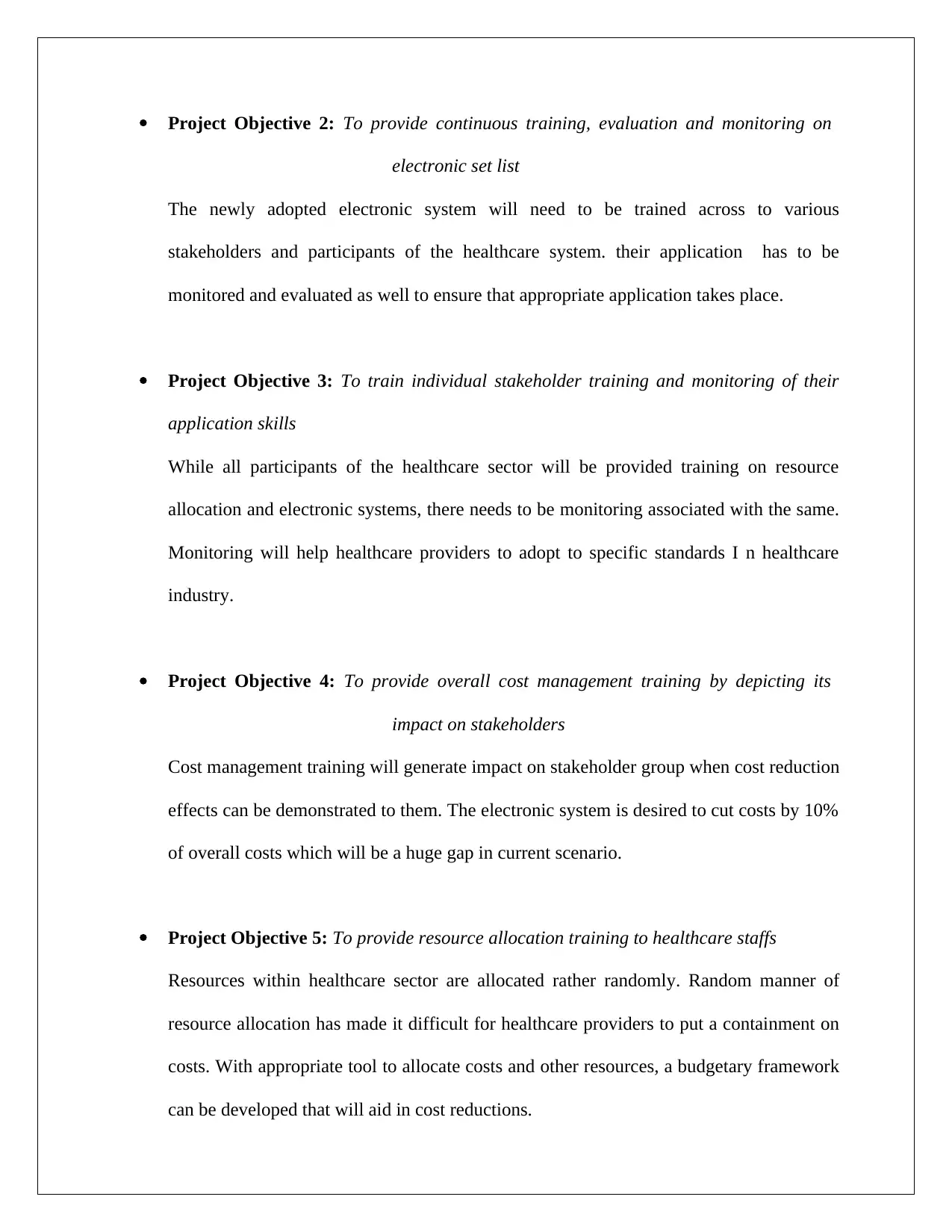
Project Objective 2: To provide continuous training, evaluation and monitoring on
electronic set list
The newly adopted electronic system will need to be trained across to various
stakeholders and participants of the healthcare system. their application has to be
monitored and evaluated as well to ensure that appropriate application takes place.
Project Objective 3: To train individual stakeholder training and monitoring of their
application skills
While all participants of the healthcare sector will be provided training on resource
allocation and electronic systems, there needs to be monitoring associated with the same.
Monitoring will help healthcare providers to adopt to specific standards I n healthcare
industry.
Project Objective 4: To provide overall cost management training by depicting its
impact on stakeholders
Cost management training will generate impact on stakeholder group when cost reduction
effects can be demonstrated to them. The electronic system is desired to cut costs by 10%
of overall costs which will be a huge gap in current scenario.
Project Objective 5: To provide resource allocation training to healthcare staffs
Resources within healthcare sector are allocated rather randomly. Random manner of
resource allocation has made it difficult for healthcare providers to put a containment on
costs. With appropriate tool to allocate costs and other resources, a budgetary framework
can be developed that will aid in cost reductions.
electronic set list
The newly adopted electronic system will need to be trained across to various
stakeholders and participants of the healthcare system. their application has to be
monitored and evaluated as well to ensure that appropriate application takes place.
Project Objective 3: To train individual stakeholder training and monitoring of their
application skills
While all participants of the healthcare sector will be provided training on resource
allocation and electronic systems, there needs to be monitoring associated with the same.
Monitoring will help healthcare providers to adopt to specific standards I n healthcare
industry.
Project Objective 4: To provide overall cost management training by depicting its
impact on stakeholders
Cost management training will generate impact on stakeholder group when cost reduction
effects can be demonstrated to them. The electronic system is desired to cut costs by 10%
of overall costs which will be a huge gap in current scenario.
Project Objective 5: To provide resource allocation training to healthcare staffs
Resources within healthcare sector are allocated rather randomly. Random manner of
resource allocation has made it difficult for healthcare providers to put a containment on
costs. With appropriate tool to allocate costs and other resources, a budgetary framework
can be developed that will aid in cost reductions.
Paraphrase This Document
Need a fresh take? Get an instant paraphrase of this document with our AI Paraphraser
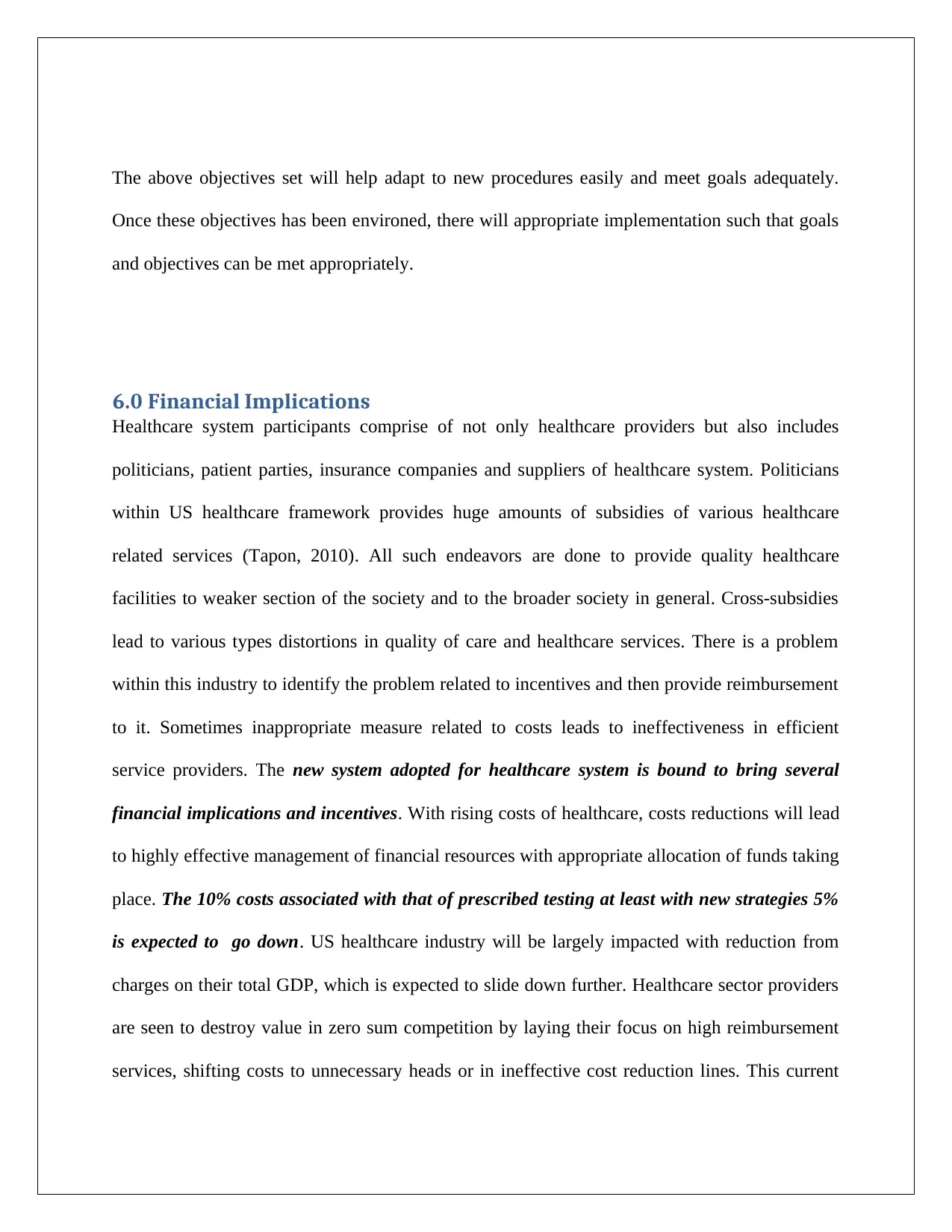
The above objectives set will help adapt to new procedures easily and meet goals adequately.
Once these objectives has been environed, there will appropriate implementation such that goals
and objectives can be met appropriately.
6.0 Financial Implications
Healthcare system participants comprise of not only healthcare providers but also includes
politicians, patient parties, insurance companies and suppliers of healthcare system. Politicians
within US healthcare framework provides huge amounts of subsidies of various healthcare
related services (Tapon, 2010). All such endeavors are done to provide quality healthcare
facilities to weaker section of the society and to the broader society in general. Cross-subsidies
lead to various types distortions in quality of care and healthcare services. There is a problem
within this industry to identify the problem related to incentives and then provide reimbursement
to it. Sometimes inappropriate measure related to costs leads to ineffectiveness in efficient
service providers. The new system adopted for healthcare system is bound to bring several
financial implications and incentives. With rising costs of healthcare, costs reductions will lead
to highly effective management of financial resources with appropriate allocation of funds taking
place. The 10% costs associated with that of prescribed testing at least with new strategies 5%
is expected to go down. US healthcare industry will be largely impacted with reduction from
charges on their total GDP, which is expected to slide down further. Healthcare sector providers
are seen to destroy value in zero sum competition by laying their focus on high reimbursement
services, shifting costs to unnecessary heads or in ineffective cost reduction lines. This current
Once these objectives has been environed, there will appropriate implementation such that goals
and objectives can be met appropriately.
6.0 Financial Implications
Healthcare system participants comprise of not only healthcare providers but also includes
politicians, patient parties, insurance companies and suppliers of healthcare system. Politicians
within US healthcare framework provides huge amounts of subsidies of various healthcare
related services (Tapon, 2010). All such endeavors are done to provide quality healthcare
facilities to weaker section of the society and to the broader society in general. Cross-subsidies
lead to various types distortions in quality of care and healthcare services. There is a problem
within this industry to identify the problem related to incentives and then provide reimbursement
to it. Sometimes inappropriate measure related to costs leads to ineffectiveness in efficient
service providers. The new system adopted for healthcare system is bound to bring several
financial implications and incentives. With rising costs of healthcare, costs reductions will lead
to highly effective management of financial resources with appropriate allocation of funds taking
place. The 10% costs associated with that of prescribed testing at least with new strategies 5%
is expected to go down. US healthcare industry will be largely impacted with reduction from
charges on their total GDP, which is expected to slide down further. Healthcare sector providers
are seen to destroy value in zero sum competition by laying their focus on high reimbursement
services, shifting costs to unnecessary heads or in ineffective cost reduction lines. This current
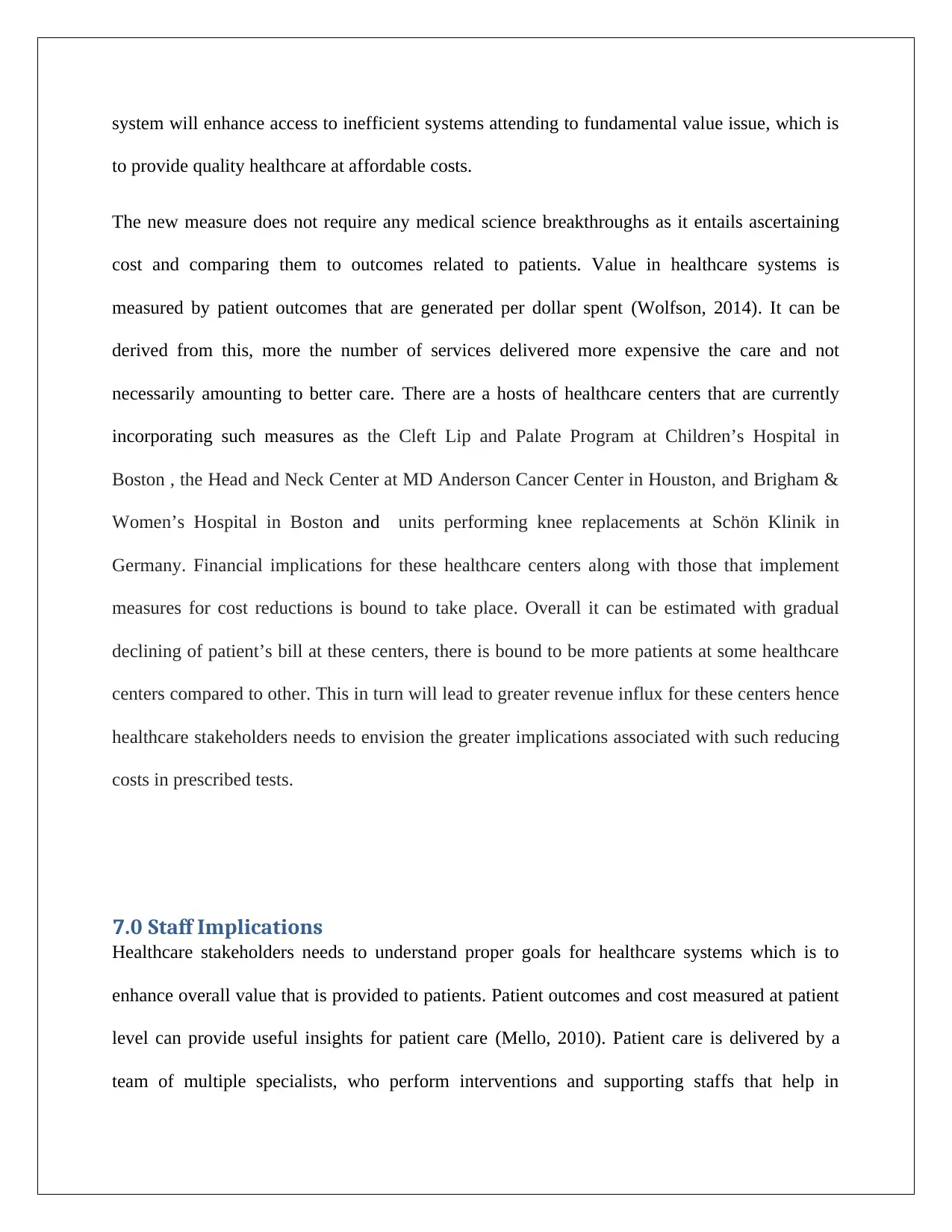
system will enhance access to inefficient systems attending to fundamental value issue, which is
to provide quality healthcare at affordable costs.
The new measure does not require any medical science breakthroughs as it entails ascertaining
cost and comparing them to outcomes related to patients. Value in healthcare systems is
measured by patient outcomes that are generated per dollar spent (Wolfson, 2014). It can be
derived from this, more the number of services delivered more expensive the care and not
necessarily amounting to better care. There are a hosts of healthcare centers that are currently
incorporating such measures as the Cleft Lip and Palate Program at Children’s Hospital in
Boston , the Head and Neck Center at MD Anderson Cancer Center in Houston, and Brigham &
Women’s Hospital in Boston and units performing knee replacements at Schön Klinik in
Germany. Financial implications for these healthcare centers along with those that implement
measures for cost reductions is bound to take place. Overall it can be estimated with gradual
declining of patient’s bill at these centers, there is bound to be more patients at some healthcare
centers compared to other. This in turn will lead to greater revenue influx for these centers hence
healthcare stakeholders needs to envision the greater implications associated with such reducing
costs in prescribed tests.
7.0 Staff Implications
Healthcare stakeholders needs to understand proper goals for healthcare systems which is to
enhance overall value that is provided to patients. Patient outcomes and cost measured at patient
level can provide useful insights for patient care (Mello, 2010). Patient care is delivered by a
team of multiple specialists, who perform interventions and supporting staffs that help in
to provide quality healthcare at affordable costs.
The new measure does not require any medical science breakthroughs as it entails ascertaining
cost and comparing them to outcomes related to patients. Value in healthcare systems is
measured by patient outcomes that are generated per dollar spent (Wolfson, 2014). It can be
derived from this, more the number of services delivered more expensive the care and not
necessarily amounting to better care. There are a hosts of healthcare centers that are currently
incorporating such measures as the Cleft Lip and Palate Program at Children’s Hospital in
Boston , the Head and Neck Center at MD Anderson Cancer Center in Houston, and Brigham &
Women’s Hospital in Boston and units performing knee replacements at Schön Klinik in
Germany. Financial implications for these healthcare centers along with those that implement
measures for cost reductions is bound to take place. Overall it can be estimated with gradual
declining of patient’s bill at these centers, there is bound to be more patients at some healthcare
centers compared to other. This in turn will lead to greater revenue influx for these centers hence
healthcare stakeholders needs to envision the greater implications associated with such reducing
costs in prescribed tests.
7.0 Staff Implications
Healthcare stakeholders needs to understand proper goals for healthcare systems which is to
enhance overall value that is provided to patients. Patient outcomes and cost measured at patient
level can provide useful insights for patient care (Mello, 2010). Patient care is delivered by a
team of multiple specialists, who perform interventions and supporting staffs that help in
⊘ This is a preview!⊘
Do you want full access?
Subscribe today to unlock all pages.

Trusted by 1+ million students worldwide
1 out of 24
Related Documents
Your All-in-One AI-Powered Toolkit for Academic Success.
+13062052269
info@desklib.com
Available 24*7 on WhatsApp / Email
![[object Object]](/_next/static/media/star-bottom.7253800d.svg)
Unlock your academic potential
Copyright © 2020–2025 A2Z Services. All Rights Reserved. Developed and managed by ZUCOL.




